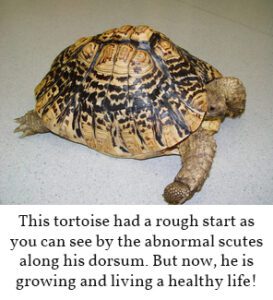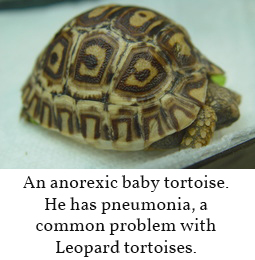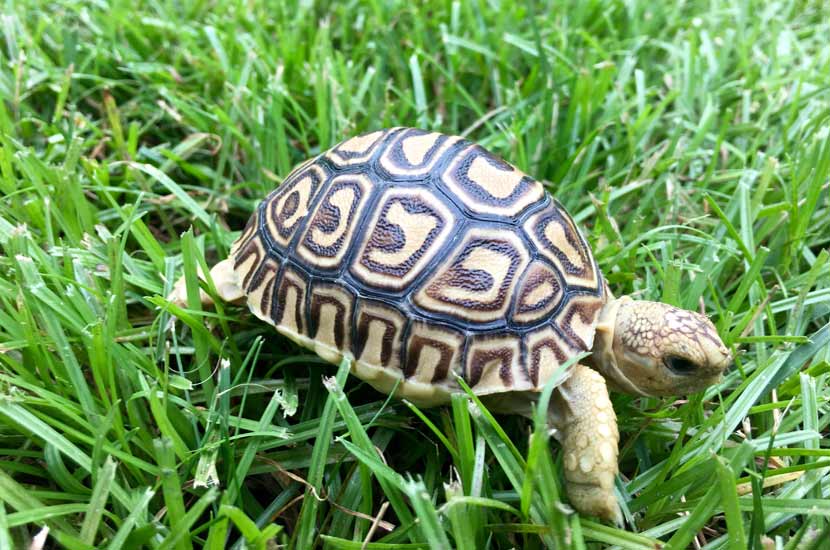Erica Mede, CVT
Photos and edited by Susan Horton, DVM
 Beautiful and large, these gentle giants will move furniture, plants, and anything that they find to be in their way. The Swahili call these animals, “tortoise of the elders” due to their long life span and others refer to this grassland tortoise as the Mountain tortoise. This animal will grow to be a large and long lived pet that will need large amounts of room and food to remain healthy in your home.
Beautiful and large, these gentle giants will move furniture, plants, and anything that they find to be in their way. The Swahili call these animals, “tortoise of the elders” due to their long life span and others refer to this grassland tortoise as the Mountain tortoise. This animal will grow to be a large and long lived pet that will need large amounts of room and food to remain healthy in your home.
Zoos and shelters are inundated with these animals and most are no longer accepting new animals due to over crowding. If you are interested in this tortoise, consider adopting a juvenile or an adult from a reptile shelter or supporting a local reptile sanctuary.
Natural History
There are two subspecies of Leopard tortoise: the Stigmachelys pardalis pardalis which is the most common species found in captivity, and the Stigmachelys pardalis babcocki. Leopard tortoises are found in eastern and southern Africa from Ethiopia to Botswana and South Africa. The climate is dry and hot and the terrain is rocky with plains of dry or moist savanna, dry forests, thorn brush and grass. This is not a hibernating species!
Description
The carapace (top shell) is domed with steep sides with slightly conically domed vertebral scutes or “humps” to assist the tortoise in righting itself if it is knocked over on to its back. The carapace is generally whitish, cloudy yellow to light brown, reddish brown, or olive with scattered dark brown to black spots, speckles, and streaks. The pattern does however fade with age. The plastron (bottom shell) is a yellowish color with black speckles and streaks radiating from the center. The average carapace length for this species is 12-18 inches long but has been known to grow up to 31 inches.
The skin of the Leopard tortoise is generally yellow or grayish-brown. Occasionally, the skin will have black spots. The rear legs have large, conical spurs on the heel. The back side of the rear legs also has two very large conical spurs.
Juveniles have a rounded and relatively flat carapace. The carapace is generally a dull yellow with reddish brown to black margins. Growth during the first few months of life is slow with accelerated growths around 21-33 months of age. At three years of age most will weigh around a kilogram (2.2 pounds) and five kilograms at 12 years old. Once the tortoises are sexually mature the rate of growth severely decreases.
The Leopard tortoise has three defense mechanisms. The first is to retract the limbs under the shell. The second is to hiss loudly. If the tortoise is picked up it will urinate copiously which is the third defense mechanism.
Sexing
The male Leopard tortoise has a longer, thicker tail and the plastron scutes directly above the tail are pointed and appear to be the letter “V’. The female has a shorter tail than the mail and the plastron scutes directly above the tail are long and rounded like the letter “U”. Males are also notably smaller than females.
Enclosure
Leopard tortoises are diurnal often retreating to shelter once dark. Logs and bushes make excellent shelters as do turned over cement mixing trays with a door cut out, wooden hide boxes, etc. All enclosures should be tortoise proof. Solid wood trim or ram resistant bricks are essential for indoor and outdoor enclosures larger than aquarium tanks. As the tortoise grows, a custom built wooden enclosure will be required.
Substrate for young tortoises should be rather simple and easily cleaned. The most recommended substrate for juveniles is reptile carpet or butcher paper with hay on top of it. Rabbit pellets are frequently used in the pet trade for hatchlings to juveniles but recently has been found to cause deformities in these fast growers due to improper positioning of limbs in hatchlings. Ideally adults should be housed with hay substrate for their outdoor and indoor enclosures as well. Daily spot cleaning is required with a complete substrate change every 2-3 weeks. Gravid females (females with eggs) may require a dig box of dirt and sand to lay their eggs. Rocks, tree trunks, boulders, and roots create obstacles and mental stimulation.
During the rainy season, the temperature is between 82° and 95° F. This is best reproduced in a green house set-up or with circulatory heaters. Metal vapor bulbs are excellent for the bright lighting and 95-104° F basking spot for large adult enclosures. At night the temperatures should be around 68-86°F. Proper ventilation will prevent over heating but drafts need to be avoided.
The lighting in the cage should replicate the lighting of the wild. There should be a high level of illumination and heat. Adults with large pens will require several UVB bulbs. All tortoises should be exposed to UVB light or natural sunlight for at least 8 hours a day and total illumination for 10-14 hours. Relative humidity of 40-60% is ideal during the day and 70-80% at night which can be accomplished by misting the substrate at night.
Hatchlings
Hatchlings can be kept in a 10 gallon tank and increased in size from there. Remember, as your tortoise grows he will need a custom enclosure! This is not a species that can be kept in aquariums all their lives. Many people think they will not outgrow their cage like goldfish. In both instances, of the tortoise and the goldfish, this is false and they will continue to grow despite cramped conditions. As hatchlings grow they will need a two foot by two foot cage up to a four foot by eight foot cage. A turtle table is an excellent set-up and many plans for these enclosures can be found on the internet.
Indoor enclosures should be spacious and heated. Adults will require brick, concrete, and armored glass. Some people use heated basements or attics where the whole or at least most of the space can be dedicated to the tortoise enclosure. The enclosure space should be at least four times the carapace length. If two animals are being kept together, double the size of the enclosure and add an additional 10% for each animal after three tortoises.
Outdoor enclosures should be large, sunny, and protected from the wind and predators. An adjoining spacious and heated building is required if the tortoise is to remain outdoors year round. Remember, the driest season in the mid-western United States is like the rainy season in its natural African habitat. Some people use a green house to house their tortoise. Leopard tortoises can learn to use a rubber flap dog door. The enclosure should be free of large trees or high shrubs that will create large areas of shade. Check with your local authorities before constructing any outdoor pen as permits may be required. If the temperature is constantly below 60°F degrees bring the tortoise inside. The fence to any out door area should be at least 12-24 inches into the ground and at least 18-24 inches in height. A word of caution, escape attempts never cease and these tortoises will climb wire mesh fences.
Feeding
 Diet is the most important aspect of tortoise care and sadly, one of the most neglected and misunderstood. Remember, you are what you eat, if you want a healthy and fully developed tortoise you must feed it healthy and appropriate foods. Feeding foods to high in fat and protein will cause accelerated growth, shell deformities, and other health problems that will severely shorten the life of your pet. Never feed bread, cookies, oats, pasta, rice, or cat/dog food! These are harmful to your pet’s nutrition and health!
Diet is the most important aspect of tortoise care and sadly, one of the most neglected and misunderstood. Remember, you are what you eat, if you want a healthy and fully developed tortoise you must feed it healthy and appropriate foods. Feeding foods to high in fat and protein will cause accelerated growth, shell deformities, and other health problems that will severely shorten the life of your pet. Never feed bread, cookies, oats, pasta, rice, or cat/dog food! These are harmful to your pet’s nutrition and health!
The primary portion (85%) of the Leopard tortoise diet should be grass and hay high in fiber. Grasses, weeds, leaves, and flowers are essential to good health. Fiber deficiency leads to metabolic bone disease and diarrhea while also making them susceptible to parasites. A pasture of grass, dandelion, herbs, and clover outdoors is the best option for these animals. If a pasture is restricted due to size, fresh cut works as well. Orchard grass/hay, timothy grass/hay, and Bermuda grass/hay are excellent especially during those winter months when the tortoise may be housed inside. Leopard tortoises should be given as much opportunity to graze outdoors as possible.
Vegetables and fruit should be fed out in smaller portions. Vegetables should make up no more than 10% of the diet and fruit never more than 5% of the diet. Too much fruit will cause diarrhea and colic. Chopped salads are an excellent way to ensure a tortoise does not pick out their favorite foods only. Vegetables for human consumption are high in protein and fruits are high in sugar both of which in excess are harmful to your tortoise. Moderation is key in this case. Dark leafy greens, endive, and cactus pads are favorites as well as pumpkin!
Calcium supplements should be given to adult tortoises two times a week. Actively reproductive females should be given the calcium every day while gravid until they lay their eggs. Calcium supplements should not have phosphorous in it. Juveniles should be given calcium four times a week and vitamin-mineral supplements once a week until growing slows. Hatchlings are given vitamin-mineral supplements once a week and calcium daily.
Clean, fresh water should always be available to Leopard tortoises. These tortoises have an ability to store substantial amounts of fluid and also to discharge the substantial amounts of fluid as a defense mechanism as well. Soaking weekly is recommended. Water should be provided in a shallow water hole, pan or bowl depending on the enclosure.
 Common Medical Problems
Common Medical Problems
Secondary Nutritional Hyperparathyroidism (MBD, Metabolic Bone Disease)
This disease occurs for many reasons with the most common being hypocalcemia (decreased calcium in the body). This can cause shell deformities, bone deformities, constipation, and even death in your tortoise. This dietary disease is correctable but the damage to the body may not be reversed. Please, make an appointment with Chicago Exotics if you notice any shell deformities.
Anorexia
Leopard tortoises typically feed well until mid-December when they will retreat into the corner of the enclosure and sometimes refuse food. This is natural and normal. When this happens make sure that all temperatures are appropriate. If this persists past February, nasal discharge is seen, or diarrhea occurs, contact Chicago Exotics for an appointment.
Parasites
 Your tortoise can become infested or already have endoparasites. These, if left untreated can be destructive to the health of your pet. If you notice anorexia, diarrhea or extreme lethargy please contact Chicago Exotics for an appointment.
Your tortoise can become infested or already have endoparasites. These, if left untreated can be destructive to the health of your pet. If you notice anorexia, diarrhea or extreme lethargy please contact Chicago Exotics for an appointment.
Pyramiding
This is a form of MBD. The shell has a build up of keratin becoming tall pillars before becoming soft and flattening. Liver and kidney disease can occur with this as well. Avoid lack of exercise, dehydration, grain based diets, fiber deficiency, and too much food. This is common in the United States. If you see signs of pyramiding call Chicago Exotics for an appointment.
References and Sources
Chelonian Library: Leopard and African Spurred Tortoise, Holger Vetker
Chelonian Research Foundation, www.chelonian.org
African Tortoise Care, www.africantortoise.com
Complete Herp Care: Sulcata and Leopard Tortoises, E.J. Pirog
If you have any questions, please feel free to call us at (502) 241-4117.

